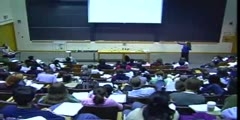Lec 8 - Demographic Transition in Europe; Fertility Decline
"Lec 8 - Demographic Transition in Europe; Fertility Decline" Global Problems of Population Growth (MCDB 150) Prior to Malthus, population growth was seen as good for the power and wealth of a country. The rapid population growth of America was crucial in expelling England (via the Revolution) and France (via the Louisiana Purchase) from the US. But in fact, the numbers of the poor were growing in Europe in the 1700s. Malthus argued that poverty was due to an imbalance between people and resources; since population could rise very fast, it could always outstrip any gains in productivity. He did not anticipate an exponential increase in production or a voluntary decrease in fertility. However, Malthus' thinking is still important because high population levels and environmental limitations are in fact problematic today. By the eighteenth and nineteenth centuries, mortality was falling in Europe and this caused a population explosion. The productivity gains of the Industrial Revolution were nearly balanced by the increased population; per capita income of the working classes was not much improved. Fertility didn't drop until late in the nineteenth century; per capita income started to grow rapidly. The reason for the fertility decline is not well explained by declining mortality or rising standard of living or any other socioeconomic factor. The mortality and later fertility drop is called the Demographic Transition. The extension of lifespan and the freedom from continual childbearing and child rearing is one of the most important changes ever in what it means to be a human. 00:00 - Chapter 1. Praises of European Population Growth 12:32 - Chapter 2. Malthusian Times 26:59 - Chapter 3. Analysis of Malthus 38:11 - Chapter 4. Historic Population Trends in Europe 45:26 - Chapter 5. Fertility Decline and Stopping 58:10 - Chapter 6. Theories Explaining the Demographic Transition Complete course materials are available at the Open Yale Courses website: http://open.yale.edu/courses This course was recorded in Spring 2009.
Video is embedded from external source so embedding is not available.
Video is embedded from external source so download is not available.
Channels: Others
Tags: Lec 8 - Demographic Transition in Europe; Fertility Decline
Uploaded by: yalepopulatngrth ( Send Message ) on 12-09-2012.
Duration: 71m 35s
Here is the next lecture for this course
Lec 7 - Demographic Transition in Europe; ...
01:08:54 | 3115 viewsLec 9 - Demographic Transition in Europe
01:06:27 | 2773 viewsLec 14 - Demographic Transition in Develo ...
01:10:36 | 3477 viewsLec 22 - Media and the Fertility Transiti ...
01:16:43 | 3868 viewsLec 11 - Low Fertility in Developed Count ...
01:12:12 | 3339 viewsLec 13 - Demography and Asset Pricing: Wi ...
01:12:22 | 3330 viewsChemical Science - Transition Metals - Le ...
49:42 | 15169 viewsChemical Science -Transition Metals - Lec ...
50:39 | 20494 viewsTransition Period
00:27 | 4001 viewsLec 20 - Successor States of Eastern Europe
44:34 | 3473 viewsLec Last - Potential Energy Surfaces, Tra ...
47:44 | 7253 viewsLec 13 - Fertility Attitudes and Practices
29:43 | 2687 viewsLec 19 - Economic Motivations for Fertility
01:14:02 | 2978 viewsLec 26 - Health Care Costs in US vs Europe
14:34 | 3295 viewsLec 130 - Why Europe is worried about Greece
08:09 | 2279 viewsNo content is added to this lecture.
This video is a part of a lecture series from of Yale
Lecture list for this course
Lec 1 - Evolution of Sex and Reproductive Strategies
Lec 2 - Sex and Violence Among the Apes
Lec 4 - When Humans Were Scarce
Lec 5 - Why Is Africa Different?
Lec 7 - Demographic Transition in Europe; Mortality Decline
Lec 9 - Demographic Transition in Europe
Lec 11 - Low Fertility in Developed Countries (Guest Lecture by Michael Teitelbaum)
Lec 12 - Human and Environmental Impacts
Lec 13 - Fertility Attitudes and Practices
Lec 14 - Demographic Transition in Developing Countries
Lec 16 - Population in Traditional China
Lec 17 - Population in Modern China
Lec 18 - Economic Impact of Population Growth
Lec 19 - Economic Motivations for Fertility
Lec 20 - Teen Sexuality and Teen Pregnancy
Lec 21 - Global Demography of Abortion















